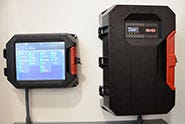July 15, 2015

Controllers for buildings have been a mainstay for the industry for years, yet as businesses expand the number of buildings, managing those systems gets more complicated. Automated Production Systems showed its new EDGE product for the first time at the World Pork Expo, and it was well received by the New Product Tour panel.
The product pulls together a range of separate systems, controls and technology and integrates them into a new user-friendly platform. This system is so advanced that the company made the decision that it would not work with its legacy controllers. It’s a fresh start for a new control system that offers both a mix of key software and innovative hardware to solve a range of issues.
Adam Weiss, director of global protein technology for AP, explained how EDGE is different than other control systems on the market. “We’ve been doing controls 20-plus years the same way — ventilation-based staging,” Weiss says. “With the EDGE there’s been advances, and we wanted to do more than just a technology update.”
He notes that Internet connectivity and a color touch screen are pretty much expected these days, so the company had to do that. But Weiss says the company stepped back and asked what they were trying to accomplish with ventilation.
“In the past adding ventilation in staging was a limitation of how the controls needed to be programmed,” he says. “That’s not how you think about providing air for your animals.”
He notes vets will talk about providing X amount of cubic feet per minute per head. “We wanted to take the technology programming out of the equation and work on how best to provide the right environment for the animals,” Weiss notes.
The design was focused on making it easy to install, easy to use and easy to program. “Everything was put into the user interface with that kind of idea in mind,” he says. “We also worked on a design so it’s all at a glance, the pertinent information is right there, and you don’t have to dig down to find it. Even from 20 feet away you can see what you’re looking for.”
Serviceability was also a directive that guided system designers – and the need to control more rooms, with multi-room control. “If you were to control an entire sow farm from one control, that’s a lot of risk,” he notes. “With that in mind, almost modeling the defense industry, we built in fail-safe and redundancy capabilities. We built in three levels of redundancy. Should any component fail, something else takes over, and ventilation still works, and things keep going.”
The system is also designed to “know” what the producer knows. Once installed, the system knows every fan and its location and capability. That’s important. Should a fan fail in a pit, the system knows there are four other fans in the pit and knows their location. It can keep air moving (while also alerting you a fan needs repair). That’s one way the system manages risk.
Modular design
When you look at the system, you see the monitor — or control interface — where you can issue instructions and work on setup. It’s a tough interface that’s designed to be intuitive, which Weiss demonstrated. The controller interface can manage up to 64 buildings.
The control panel - where systems are connected and managed — has a modular design. Pullout panels have pull-off boards for snap-in/snap-out flexibility for repairs and expansion. Even plugs are designed to make it simple to reconnect a board or system. Each board is an individual controller that’s run by the master unit.
Weiss notes the software helps the producer in a number of ways. For example, once it knows the fans and location for a building, the user can just program the cfm per head and the system will do the math, and the work, to achieve that goal.
Remove 200 animals from a 2,400-head building, and once you tell the controller, it automatically matches the airflow for the remaining animals — saving energy while still maintaining animal comfort.
Three-stage fail-safe
A key feature of the system is the fail-safe and redundancy offered. First level would be a second master controller that is linked — if one fails the other automatically takes over.
If the master controls fail, each card in the panel is its own controller and will continue to manage the building until the master can be repaired.
If there’s a catastrophic failure and the panels go down, there is a “hardwired” system that carries out very specific actions to maintain animal health. “That can be lowering building curtains, or running specific fans,” Weiss says. “That’s hardwired into the system and occurs in a way that when there’s a failure, it closes a circuit and initiates the actions.”
Panel member Joe Zulovich, an ag engineer, likes that final feature, noting the approach offers an added level of safety for the system without having to mess with external/remote thermostats.
The entire New Product Tour panel found the AP EDGE to be an innovative product with a range of features that set it apart from other control systems on the market. You can learn more by visiting automatedproduction.com/EDGE.
You May Also Like



